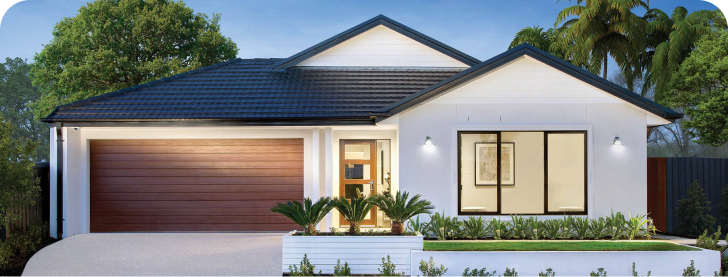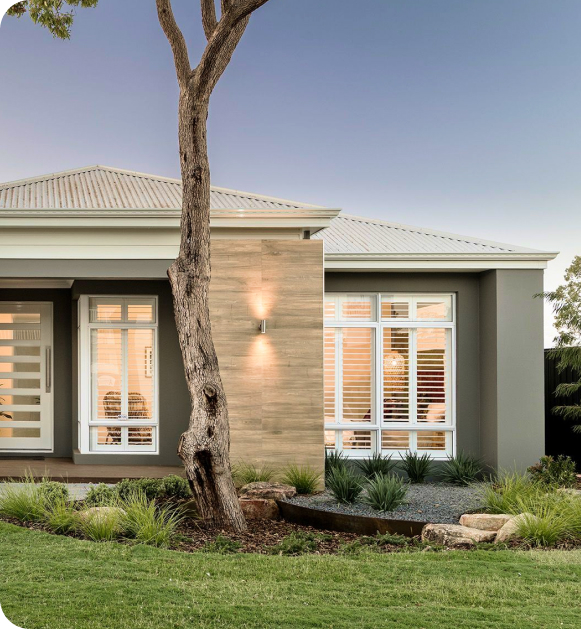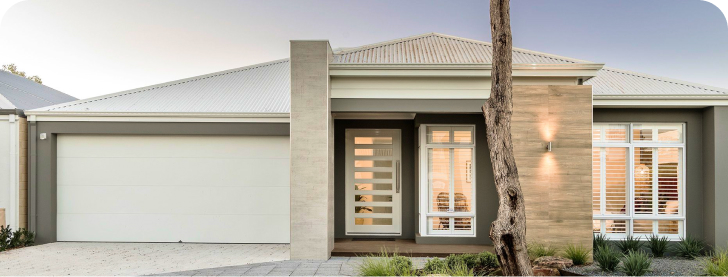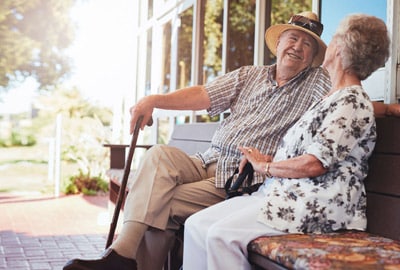
It's hard to argue with the fact that all seniors have gone through a hard school of life and therefore deserve to meet old age in a place with maximum comfort and coziness. Among all housing options, detached ADUs or granny flats are best suited for these purposes.
The biggest advantage of this type of housing is that you live with elderly parents or relatives on the same territory but with the preservation of personal boundaries. So, your family is in the main house, and elderly people are in the detached accessory dwelling unit. At the same time, the living area will be completely safe for the health of older adults.
In this review, we will talk about all the stages of creating a universal design ADU, as well as reveal information about what benefits an age-friendly home can bring.
Certain rules underlie at the heart of creating any design, following which will provide the desired result, and age-friendly style is no exception.
We highlight five fundamentals that need to be taken into account when planning a room:
Now that you have knowledge about the basics of universal ADU design for aging family members, we can take the next step and talk about specific techniques that will make residents' lives safer, more practical, and more comfortable.
Before we move on to age-friendly design solutions for specific rooms, such as a bath or a kitchen. First of all, it makes sense to discuss universal principles that fit into any space and greatly simplify the living conditions of the older generation.
It is not difficult for young people to bend down several times a day to the outlet or switch, which is located below the waist. However, for older adults, these are all difficult challenges that cause a lot of inconvenience. Another nuisance can be the wires scattered on the floor, for which it is easy to catch and fall. In this regard, we recommend placing the sockets at an accessible height and hiding the wires under the baseboard.
Another potential threat is a slippery floor, so during the planning of the ADU design, take this point into account. Budget options for anti-slip flooring are laminate, linoleum, and carpet; however, if you have access to a more solid budget, then you can opt for natural parquet, cork, or polymer floors.
With age, the motor skills of the hands also deteriorate, so complex mechanisms for opening windows or drawers can become another obstacle in the normal course of life. A perfect solution that will help overcome barriers is a magnetic latch. Magnets have many benefits, they are easy to operate, reliable enough to prevent a window or drawer from accidentally opening, and they will never break.
Overall, all these features will help make existing homes more adapted to the needs of aging relatives, and most importantly, the performance of household tasks will become much more practical and simple.
Universal design features always include a step about the organization of lighting in each room of your age-friendly ADU because it is necessary to take special care of the eye health of elderly people. Creating accessible lighting involves four fundamental points. First, make a choice in favor of matte rather than bright lighting inside the building. Bright light from lamps and multiple glares harm the eyes of older people. In contrast, a matte shade softens the effect and has a positive impact on blood pressure.
Secondly, provide additional lighting where necessary, in particular, in the kitchen. These can be built-in perimeter lamps or fluorescent lighting. Thirdly, when planning living space, keep in mind that natural light penetrates into the room as much as possible.
Finally, create the conditions for deep red light therapy. This option relates more to the aspect of the "Smart Home"; it is not cheap, but it has many undeniable benefits. Two to three minutes in a room with red lighting will assist in relaxing the eyes, increasing the tone of the retina, as well as reducing headaches and migraines.
We have already partially covered the topic of flooring that complies with the principles of an age-friendly home. However, for homeowners, it is most important not to lose sight of other surfaces in the house.
The following aspects will help you develop an even safer housing stock that will be suitable for aging in place:
In sum, the modern construction industry provides many resources that will help get rid of the most important problem for the elderly. If a young person loses their balance, then his reaction will allow him to stand on his feet; this will not happen with elderly people; however, if you adhere to the above tips, then no one will harm themselves.
In any kitchen, with a cursory glance, you can find a wide variety of resources threats the health of the elderly. So, to prevent unpleasant situations, you can, firstly, lay a non-slip floor covering and lower the height of cabinets and countertops so that a person can cook while sitting down. Secondly, it does not hurt to equip drawers and lockers with a door closer function, as well as add magnetic latches instead of uncomfortable handles. Thirdly, if the furniture has sharp corners, then you can ask wood artisans to smooth them out or paste felt patches. Finally, all doors should open to the side and not to the top so that the person does not pull his back.
More than one research shows that the bathroom is the place of receiving the majority of household injuries among the population of all ages, especially elderly people. In this regard, to create a bathroom with a universal design, first, you can install grab bars in the bath to provide the ability to take a shower without fear of falling. Then you can mount additional handrails next to the toilet and sink; they will definitely not be superfluous.
The next stage will be the creation of a step into the shower or bath, as well as the installation of a special folding chair. Do not forget about the insulation of all sockets, the accessible distance to hygiene items, and the use of special anti-slip rubber coatings.
In the future, you can also install cold and hot water sensors to avoid the risk of burns. If, at the planning stage, you realize that the new home will be designed for aging in place, then an additional 10-15 square feet in the bathtub will level out limited physical capabilities.
Agree that it is very difficult to imagine accessory dwelling units without doors, and exactly this element among all barriers for age-related people can cause the most inconvenience already in the course of entering the room.
You need to approach the development of doorways with full responsibility, and the following tips will help you with this:
Overall, these tips apply not only to the front door but also to all doors in your house or ADU. After their implementation, the transition of aged residents between rooms will be simplified many times.
As we noted earlier, vision can deteriorate significantly with age, so one of the hidden points that young people do not pay attention to is the creation of contrasts in the room. The primary task is to use contrasting shades of doors and walls, as well as walls and floors, as it helps to better distinguish boundaries and landmarks. In addition, the contrast of furniture and lighting can play a key role because if they have the same shade, it can end up in an accidental bruise or fall. Finally, create a contrast between the colors of the handrails and the places to which they are attached so that elderly people can easily distinguish them and quickly grab hold of them.
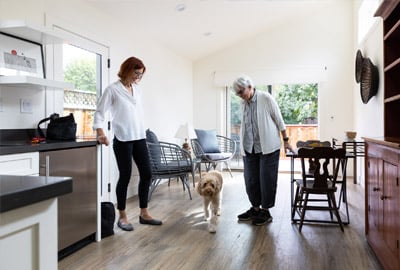
There is an opinion that age-old people cannot establish a connection with modern gadgets. However, it will be much more pleasant to meet age in place with them.
We have collected the top five technologies that will serve for the benefit of every person living in ADU:
On the whole, the choice of technologies does not end there, and you can always discuss more options with your developer.
Up to this point, we talked about universal design features inside your housing unit; however, for good health, elderly people need fresh air, and in this case, you may be interested in the option of an outdoor living area. There are various locations, e.g., you can create a patio with hammocks and a fireplace, a wooden gazebo, or a family room lined with glass, where old people can communicate with each other and play with grandchildren. On par with this, the development of outdoor living areas will increase the value of your property.
The most important advantage of universal design is your peace of mind regarding the safety of living with age-related relatives. However, there are other benefits to this matter. In particular, you can create all the conditions for a good time with relatives; the implementation of the age-friendly home project will increase the value of property in the real estate market, as well as provide the opportunity to receive rental income in the future.
It is very difficult to name the exact figure because final costs depend on the number and scale of universal design elements that you want to integrate into the current home system. Of course, the most inexpensive options are the installation of individual components and the reconstruction of the entire room will cost more, and the most expensive option is the creation of an age-friendly house with a "Smart home" system.
To do this, it is necessary to understand the needs of the older generation. However, universal options provide easy access to drawers and cabinets, creating eye-friendly lighting as well as implementing a safe kitchen and bath draft. The most important points remain the installation of non-slip floors in the building and sufficient width of space.



